Best Pond Vacuum Cleaners
1) Oase PondoVac Classic Review (UK link)
- Max. Suction depth: 6 ft.High-power suction to a depth of 59 inch.Maximum suction depth of 78 inch
- Suction hose length: 13 ft
- Operating voltage: 110-120 Volt / 60Hz. Power consumption: 1200-1400w
Our favorite cost-effective pond vacuum cleaner is the classic Oase PondoVac. Oase have long been established as a reputable power vac supplier in the pond industry, and their entry level model is a fantastic option for small-medium sized ponds. The vacuum is rated at 1200w and has a maximum suction depth of 6ft, with a fairly generous 13ft total hose length. When in operation, there is a clear window built into the main hose so you can see the debris being lifted and make sure the vacuum is working.
Unlike its bigger brother, the Oase PondoVac 4, the classic model features just a single suction chamber which holds the sucked up debris. This doubles as both a holding chamber and a discharge chamber. When the vac becomes full, suction will stop and the contents of the chamber will automatically be discharged from the chamber to save time with manual removal. The vacuum comes with a fairly decent debris holding bag which works quite well, but we found that smaller debris often got through and found itself back in the water through the main hose when discharging.
The vacuum comes with 4 different nozzle attachments, which is great for an entry model, with each one being suited for a different purpose. You can make use of the attachments to remove very fine silt, sludge, and even small stones! They’re easy to attach and fit nice and securely when cleaning.
Even though you could technically use this pond vac for both wet and dry application, it lacks the basic dry filter options to be effective for this purpose. We strongly recommend only using this vacuum for wet surface application, as using it for dry can damage the system.
Testing this vacuum in a 2000 gallon sludge-heavy pond, the PondoVac Classic did a good job of removing bottom muck and sludge. Since the pump and suction are not quite as powerful as some larger models, it took slightly more work to clear the entire pond floor. The only real headache we ran into was the short length of the discharge hose, which reduced our options for removing the sludge. Adding an extension to this outlet may be required if you want to discharge a distance from your pond.
Overall, a powerful and cost effective small pond vacuum cleaner which should provide great cleaning for smaller ponds, however we would have liked to see a larger bag capacity and better discharge hose options. It’s also fairly light, with a convenient top handle, so is easy to carry around if needed.
How much will this vacuum cost me to run?
Assuming a charge of $0.10 per kWh (national average), the cost to run the 1200w PondoVac Classic would be approximately $0.12 per hour of full-power cleaning operation.
- Wet or dry: Wet
- Attachments: 4 different heads
- Maximum Suction depth: 6 ft
- Suction hose length: 13 ft
- Discharge hose length: 8 ft
- Power: 1200W
- Limited Warranty: 2 years
- Wheels: Yes
- Weight: 23.5 pounds
2) Oase PondoVac 4 Review (UK link)
- Max; Suction Depth: 7 Ft
- Suction Hose Length: 16 Ft
- Discharge Hose Length: 8 Ft, Max; Flow Rate: 1300 Gph
The PondoVac Classic’s bigger brother, and our most recommended overall pond vacuum – the Oase PondoVac 4. We’ve used this pond vacuum for all sorts of different ponds, ranging from large koi ponds to small planted ponds, with great results. The vacuum is incredibly versatile, and will provide great cleaning options for ponds of all shapes and sizes.
The PondoVac 4 comes with a powerful 1800w max rated pump system and a generous 16ft hose length and a 7ft maximum suction depth. The suction is powerful enough to lift both fine silt and heavy sediment, and makes short work of even the heaviest of bottom muck.
One of the best features of this pond vacuum is its dual chamber system for both collection and discharge. Unlike the PondoVac Classic which features a single chamber that switches from collection to discharge, the PondoVac 4 has two separate chambers for parallel collection and discharge.
When the PondoVac 4’s first collection chamber is nearing capacity, the vacuum will switch over to its second chamber and begin automatically discharging the contents of the first. When the second chamber is almost full, the vacuum will switch to the first again and the second chambers contents will be discharged.
We absolutely love this system, especially when working with heavy sludge or large pond surfaces, as it allows almost constant suction! Just remember, this process can take a few seconds between switches, so if your vacuum turns off in-between, this is completely normal and it’ll soon get back to work (we got worried for a second when we first tested it, too!).
On top of the great dual chamber system, the PondoVac 4 also comes with a range of different nozzle attachments for all kinds of situations. During our test cleaning we found we only really needed to use the “general purpose” wand attachment, which works very well for both thick sludge and finer debris. Since we didn’t need to switch attachments as often, cleaning was much simpler.
The length of the suction hose is also fairly good, and we were able to reach a fair amount of depth with little suction loss. The only problem we ran into when cleaning was when a small twig became jammed in the hose, so we’d recommend using a basic pond net to clear larger twigs before cleaning so you don’t need to open the vac to clean.
If you have a large pond, want faster cleaning, or have heavy sludge, the PondoVac 4 would be a better choice over the classic model. You’ll get more options, flexibility, and just better overall cleaning power! The only downside of this model, which the classic model also has, is the very short discharge hose length. If you want to discharge far from your pond, you’ll be out of luck without an extension piece. With that said, we had no other complaints and would fully recommend this pond vacuum for any size or type of pond!
How much will this vacuum cost me to run?
Assuming a charge of $0.10 per kWh (national average), the cost to run the 1800w PondoVac 4 would be approximately $0.18 per hour of full-power cleaning operation.
- Wet or dry: Both
- Maximum Suction depth: 7 ft
- Suction hose length: 16 ft
- Discharge hose length: 8 ft
- Power: 1800W
- Limited Warranty: 2 years
- Wheels: Yes
- Weight: 37.4 pounds
3) Matala Power-Cyclone Review
- Matala Power-Cyclone Pond Vacuum
- Pondvac
- Pondovac
Our final pond vacuum choice is the fairly unique Matala Power-Cyclone pond vacuum. Although similar in power and suction strength to the Oase PondoVac models, the Matala Power-Cyclone has a few distinct advantages. The first being it’s incredibly long maximum hose length at a huge 26ft; almost double the Oase PondoVac 4!
This generous hose length would be perfect for cleaning small lakes and wider ponds, allowing you to get right to the center without having to wade into the pond to finish cleaning. Since koi ponds in particular are often wider and deeper compared to wildlife ponds, the Matala Power-Cyclone is a great option for those of us with large and heavily stocked fish ponds.
The maximum suction depth is also very good, matching the Oase Models at around 6ft of maximum water depth. You may find the suction does drop off quite quickly in deeper water, as with many other vacuum models, but the great reach of the suction hose easily makes up for it.
As well as the great hose length, the Matala Power-Cyclone features one of the longest discharge hoses we’ve seen as standard on a water vacuum, providing discharge at a whopping 32ft of total length! One of our biggest gripes of the Oase models was the short discharge hose, but it’s safe to say the Power-Cyclone does not have this problem. The generous size of the discharge means you can remove waste sludge a great distance from your pond water if required.
In terms of power consumption, it’s also surprisingly efficient, requiring only 1.2kW of power in comparison to the PondoVac 4’s 1.8kW at maximum operation. Although not a huge difference, this could potentially save you money long-term, especially if you intend to use the vacuum regularly throughout the year, or for large-scale cleaning jobs which take more time to complete.
Similar to the PondoVac 4’s dual chamber water system, the Power-Cyclone vacuum also supports almost constant operation by using a unique dual pump system. As sludge and debris is suctioned out from the pond, it gets filtered and then immediately discharged from the discharge outlet. This system is very reliable and powerful, but the vacuum may require occasional cleaning around the pump after heavy use for the best operation.
In terms of accessories, the vacuum comes with 3 different length main hose attachments and 4 different head attachments for debris pick up. These are sturdy, easy to fix into place, and provide plenty of flexibility when it comes to cleaning large surfaces or tight corners. Here is a video showcasing the various accessories, hose length, and cleaning potential from the manufacturer:-
Overall, the Matala Power-Cyclone is a great, heavy duty pond vacuum for clearing heavy sludge and working with wider pond surfaces or small lakes. This would make a great vacuum if constant operation is required, or if you have a very large pond that requires more reach in terms of both suction and discharge.
How much will this vacuum cost me to run?
Assuming a charge of $0.10 per kWh (national average), the cost to run the 1200w Matala Power-Cyclone vacuum would be approximately $0.12 per hour of full-power cleaning operation.
- Wet or dry: Both
- Maximum Suction depth: 6 ft
- Suction hose length: 26 ft
- Discharge hose length: 32 ft
- Power: 1200W
- Capacity: 13.2 gallons
- Limited Warranty: 1 year
- Wheels: Yes
- Weight: 64.75 pounds
Do You Need a Pond Vacuum? Are They Worth It?
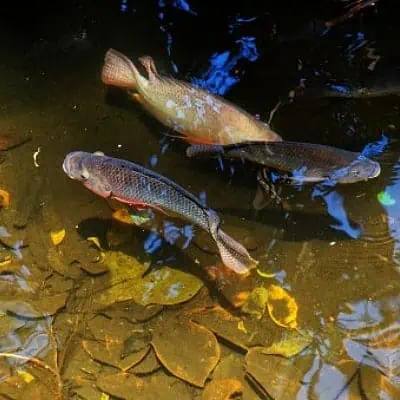
Unless you have a pond vacuum cleaner, the only other options to remove pond sludge is with a basic net or a bacteria based remover. These methods are usually more suitable for smaller ponds, or ponds without fish, as they can take time to be effective. A net won’t be able to remove the finer bottom sediment, and will just make your waters dirtier as you stir up the bottom muck. A bacteria based remover takes time to work, and can’t remove larger debris, such as twigs, gravel, or stones.
If you have heavy debris buildup, especially in a fish stocked pond, a pond vacuum would be a better option to quickly and effectively remove bottom muck. Heavy duty pond vacuums are able to remove both larger debris, as well as pond silt, so you can clear most of your pond’s bottom waste in a single session.
Having a pond vacuum also provides you much better cleaning control, allowing you to quickly remove harmful buildup at any time of the year. Most bacteria based removers only function in warmer temperatures, whereas a pond vacuum can be used during both summer and winter months.
Due to their effectiveness, pond vacuums have become very popular in koi stocked ponds in particular, as koi can be quite sensitive to excess sludge levels. They’re also a popular choice if you simply want a spotless pond floor with maximum water clarity. Even though pond muck doesn’t affect water clearness directly, fish can easily stir up the bottom muck which causes dirty water. For an extra clear pond, it’s sometimes best just to remove all the sludge!
Hand-Pumped Vacs or Power Vacs (Comparison)
There are currently two kinds of pond vacuums on the market – hand-pumped vacuums and power vacuums – each being more suited for different circumstances:-
 1) Hand- Pumped Vacuum
1) Hand- Pumped Vacuum
As the name suggests, a hand-pumped vac requires manually pumping by hand to remove pond muck. These are great little solutions for tiny ponds due to their cost and ease of use. They work by either driving water through a waste net that traps sucked up debris, or directly through a discharge hose which you can position away from your pond.
Some newer models can make use of your mains water power, too, so less work is needed to pump the water. In general, manual pump vacuums are only suited for the smallest of ponds, or even aquariums, and are not efficient enough to clear a normal fish pond reliably.
 2) Electrical Power Vacuum
2) Electrical Power Vacuum
The other type of pond vacuum is an electrical power vacuum, which uses a surface pump and is able to suck up much heavier debris compared to a hand pump. These vacuums are usually better for most ponds due to their effective suction power, which easily clears pond muck, sludge, silt, and gravel.
These powerful pond vacs are usually supplied with a range of pump ratings, flow rates, handle lengths and different hose attachments. Power vacuums provide a great level of flexibility in terms of cleaning for all kinds of pond sizes. Due to their powerful suction capabilities, they can also double as a swimming pool cleaner if you have one!
What Vacuum Type Do We Recommend?
Unless you have a tiny pond, or have no available mains socket to power an electrical vacuum, a power vacuum is recommended in most situations. They’re easier to use, provide better cleaning results, and a quality vac will simply last you years! If you have sludge, a heavily stocked koi pond, or just hate cleaning in general, a power vacuum would be a great, long-term investment.
Choosing the Best Pond Vacuum Cleaner (Things to Consider)
Great quality pond vacuums aren’t always cheap, so you need to make sure you’re making the right purchase. A good pond vacuum should provide powerful cleaning for years, as well as be reliable and cost effective. There are a few things to consider when making a purchase, the most important of which we’ve listed below –
1) Vacuum Power Consumption & Flow Rate
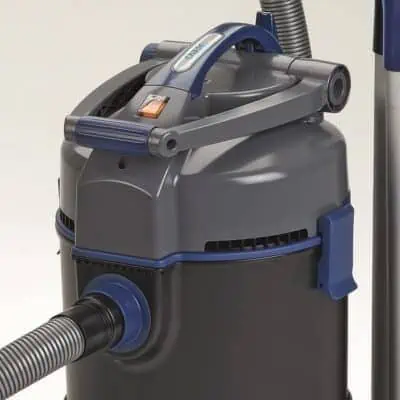
You will need to make sure the vacuum you choose is suitable for your pond’s size. If you have a larger pond with a lot of sludge build up, a more heavy duty model may be needed with a stronger internal pump. If you have a small pond with minimal sludge, a less powerful vacuum with a lower capacity may be fine. In general, selecting a more powerful model is a safer choice and will provide more flexibility in the future if you decide to expand your pond, or suddenly have a lot of leaves and debris to remove (i.e., during autumn).
Most vacuums contain internal pumps that are used to cycle water through the main collection chamber and then back into the pond or through a drainage valve. The internal pump is rated in gallons per hour (GPH), which indicates the amount of water the vacuum can cycle per hour. The higher the GPH rating, the faster the vacuum will be able to cycle water, which may be useful if you also want to use the device for drainage, water changes, or simply faster all-round cleaning.
As well as water circulation rates, you may also want to take into account a vacuum’s power consumption and energy efficiency. Since most high-end models are rated at 1000w+, they’re not exactly cheap to run for long periods. Sadly, this isn’t something you can avoid, as almost all water vacuums are very electrically hungry to power the large amount of suction and circulation required for efficient cleaning. The best way to reduce ongoing costs would be to choose a model that meets all of your cleaning criteria, which will help shorten the duration of cleaning sessions and reduce the need for possible additional cleans.
2) Attachments, Accessories, and Nozzle Sizes
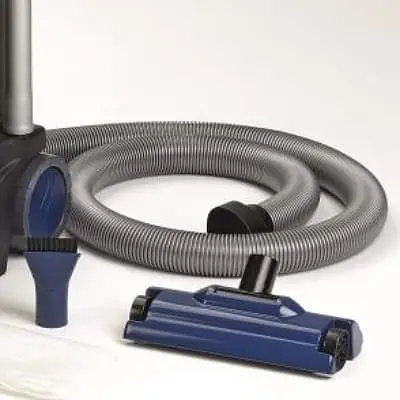
Depending on how much flexibility you want in terms of cleaning, you may need to consider the vacuum attachments and nozzle sizes. For example, a basic vacuum with a single head attachment may not be big enough to remove leaves and larger debris, but would be fine for silt. Whereas a vacuum with multiple head attachments should provide different sizes for both fine build up and large debris.
Having more options is always better, so selecting a model that provides this flexibility is a good choice. At the very minimum, you’d want at least wide brim cleaning head (pictured) and a smaller narrow head (pictured) which will allow you to clean both larger surface areas and tighter corners without much issue. Bristles on the end of attachments are also very useful for dislodging debris caught in cracks and folds of the pond liner, but will also make your water cloudy so a second clean may be necessary.
3) Hose Length vs Max Suction Depth
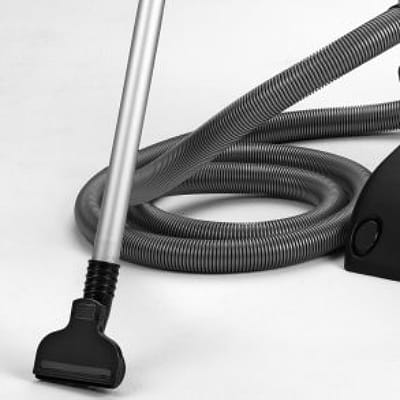
You need to make sure the power cord is long enough to plug into an available mains socket, and the hose itself needs to be long enough to reach the lowest depth point of your pond. When selecting a pond vacuum, you also need to take into account the hose length compared with the maximum suction depth.
A vacuum’s hose length is usually much longer than its max suction depth, so a hose with a length of 16ft may only have a maximum suction depth of 6ft. There is no point having a long hose if the suction doesn’t work at your required depth level!
If you have a large but fairly shallow pond, a longer hose can be useful for cleaning wide areas without the need to wade into the actual water. However, if you have a very deep but small pond, it may be better investing in a vacuum with a slightly shorter hose length but with higher suction depth potential.
The suction depth is determined primarily by the internal pump and its ability to drive water uphill (also called its “head height”). High-end vacuum models generally come with powerful suction capacity and better pumps, but you’ll still need to double-check this to be sure it meets your individual needs and criteria.
4) Vacuum Weight & Mobility Options
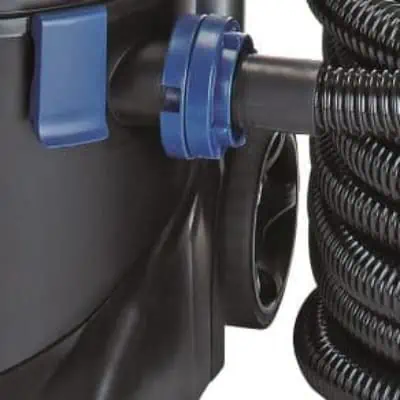
Power vacuums can be heavy, especially when full with debris, sludge and muck. Selecting a vacuum with wheels is always good practice for any size of pond or water garden. If a vacuum doesn’t have a decent set of wheels and handle design, we’d avoid it outright due to the high risk of injury.
If you’re determined on a particular model without mobility options, be sure to select one which is light enough to transport comfortably. Static water vacuums are not really designed for larger ponds, and are more so for smaller swimming pools where they can clean the entire area without moving from the poolside.
If you’re purchasing a vacuum for large-scale cleaning, which would mean you’ll likely need a higher capacity and pump strength, there is no getting around the weight of top-end models – they’re just heavy by design! If you just have a small garden pond that only needs that occasional clean every few months, choosing a lighter model may save you money, time, and some potential backache later down the line!
4) Holding Capacity & Discharge Method
How much pond muck and debris do you actually have? If you want faster removal with less cleaning, choosing a vacuum with a higher debris holding capacity is beneficial. Vacuums with a lower holding capacity generally need to be cleaned and discharged more frequently. As well as this, you will want to know what kind of discharge options are on offer. Some pond vacuums allow for much easier discharge than others, with some vacuums also providing a way to filter the water directly back into your pond.
In general, higher-end models will provide an automatic discharge function and some internal filter capability, providing the option to discharge directly into a drain or even back into the pond after filtering out the worst of the muck. Entry-level vacuums usually don’t have this capability, providing just a storage chamber which collects sludge and needs to be manually emptied once full.





i have a four-ac. pond sixteen deepest dipath what w vac could i use.